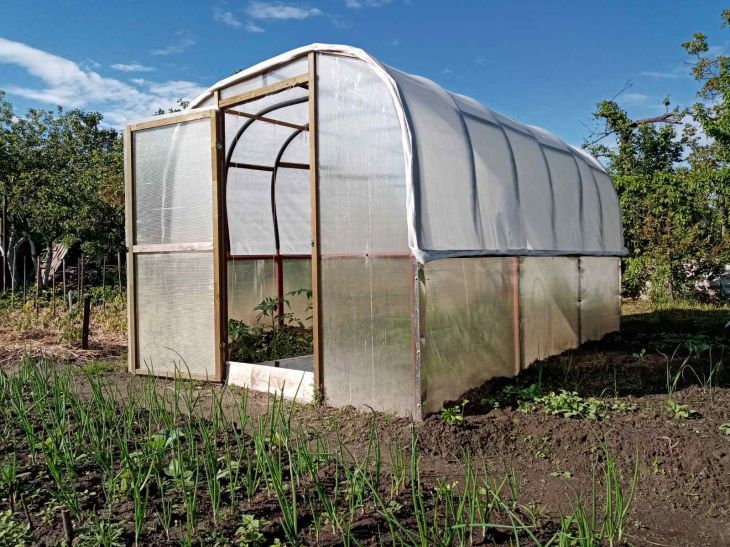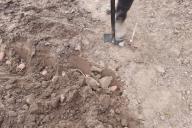Fans of organic farming, who do not use mineral fertilizers when growing tomatoes and other vegetables, know many ways to increase soil fertility in greenhouses.
It is in closed structures that soil depletion occurs with particular intensity. Therefore, without the introduction of fertilizers, it is impossible to count on a good tomato harvest.
Although tomatoes are less demanding in terms of nutrition than cucumbers, the presence of nitrogen, phosphorus, potassium and other minerals in the soil, not to mention microelements, is essential for the normal growth and development of seedlings, active fruiting and full filling of ovaries, says Anastasia Kovrizhnykh .
You can dig manure into the soil in the fall. However, fresh manure, even added in the winter, is not useful for all plants.
Manure is usually used to fertilize beds intended for growing cucumbers and other pumpkin vegetables.

But for tomatoes and other nightshade plants, only mature organic composts are used: peat-manure, leaf, garden compost or humus (well-rotted cow dung or horse manure).
An alternative to compost is green manure, aptly called “green fertilizer” by the people.
What are the benefits of green manure in a greenhouse?
Green manure helps enrich the soil in greenhouse beds with nitrogen, vermicompost and minerals.
Green manure crops are sown in greenhouses and hotbeds at the end of March, using seeds of cold-resistant crops: rapeseed, serradella, fodder beans, spring rape, oats, oilseed radish, white and yellow mustard.
These early ripening green manures build up a sufficient amount of vegetative mass within a month.
Young shoots, mown and shallowly embedded in the soil with a flat cutter, decompose in 2 weeks. That is, from the moment of planting green manure to the moment of planting seedlings in the beds, at least 1.5 months should pass.
At the same time, both the greenery and the roots remaining in the ground saturate the soil with nitrogen substances, which are vital for cultivated plants at the beginning of the growing season.
In addition, root shoots effectively loosen the soil during growth and rotting in the root canals, significantly increasing its moisture capacity and aeration.
According to experts, 3 kg of young green manure stems replace 1-1.5 kg of manure. But cow manure can only be added to the beds in the fall.
In spring, fresh organic matter, except for green manure and fully mature compost and humus, is not plowed into the beds.
Not everyone knows that mustard, radish, oats, lupine and some other green manures have phytosanitary properties.
During the process of growth and decay, plants release alkaloids, essential oils, phytoncides and other compounds into the soil, which create unfavorable conditions for the development of microorganisms dangerous to tomatoes, including fungi. These same green manures repel wireworms, nematodes and other soil parasites.
Well, another advantage of sowing green manure is the creation of favorable conditions for the development of beneficial soil microflora and the attraction of earthworms.
It is their presence in the soil that accelerates the transformation of organic matter into macro- and microelements available to the root system of tomatoes.
During their life processes, beneficial microorganisms process organic compounds and prevent the soil mixture in the beds from becoming compacted.
How to sow green manure in a greenhouse in spring
Green manure is sown superficially into the soil, which has been dug up to a depth of a bayonet shovel and loosened with a rake, and is shallowly embedded, and then the beds are thoroughly moistened using the sprinkling method.
Even in cold greenhouses, plants sprout quite quickly (3-5 days), especially if the weather is sunny.
It is advisable to water the seedlings regularly with soft water to speed up the formation of greenery. Usually, plants build up vegetative mass for 50-60 days, and they are mowed before flowering, after which they are crushed and dug in with a flat cutter.
However, when sowing green manure in greenhouses in spring, the time before planting tomato seedlings is limited, because the biomass must have time to decompose. Therefore, summer residents cut the green manure after a month so that the young sprouts have time to saturate the soil with humus and nitrogen.
And if it takes 3 weeks for green manure crops at the age of 2 months to decompose, then tender greens at the age of 4 weeks decompose in 15 days. In addition, the maximum concentration of nitrogen compounds is noted in young greens.
And to speed up the composting of green manure in the soil, immediately after plowing the biomass to a depth of 8-10 cm, the beds are watered with a solution of any preparations with effective microorganisms: “Baikal”, “Siyanie” and their analogues.
Solutions of microbiological preparations also help to activate decomposition processes: “Trichoderma green”, “Fitosporin” and their analogues.
Advantages of green manure for soil in greenhouses for tomatoes:
Increasing soil fertility.
Soil structuring.
Disinfection of beds from pathogens and pest larvae.
After the decomposition of green manure, the soil has high moisture and air permeability and is completely ready to receive tomato seedlings.
Wishing you a good tomato harvest in your greenhouses this season!
Previously, it was reported about caring for currants .









